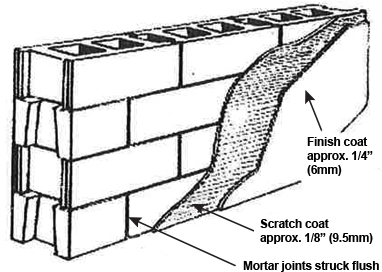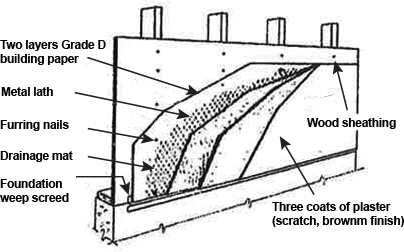Mohawk colorama portland cement stucco
is the highest type of refined concrete combining the beauty and
richness of its colors with the ruggedness and durability of quarried
stone and mansonry veneers.
Concrete for performance
Stucco for beauty
Portland Stucco
Traditional Portland cement stucco provides a tough exterior that resists attack from woodpeckers to weed whackers. That inherent toughness is beautifully complemented by the variety of colors and textures available. Appearance is an important considiration in selecting a wall cladding. You can select a color and texture consistent with the messages and image you wish to convey.
The durability of traditional stucco is complemented by its versatility. Portland cement stucco provides an ideal finish or cladding for any building construction system including concrete, concrete masonry, brick masonry, wood frame or steel frame. Portland cement stucco can be applied to any flat or curved surface wither inside or outside.
In its hardened state, stucco is a desirable facing material: hard, strong, fire-resistant, and color retentive. Because stucco is also breathable, or able to transmit moisture vapor, water cannot become trapped behind the wall. That makes it resistant to rot and fungus. Stucco has proved to be a durable wall cover in all climates, wet, dry, hot or cold.
Stucco is a combination of cementitious ingredients, aggregate, and water. Other materials are added to enhance performance of the fresh or hardened stucco. Color pigments are added to produce a wide choice of appealing colors.
Stucco colors
MOHAWK colors are the best non-fading synthetic color pigments available today. When choosing your colors, great care should be given as to the exact color range that will meet your needs. Color such as light shades of buff, light creams, light earth tones and light pastels offer good color consistency; dark tones do not weather as well.

variations
Color variation in finish stucco can be traced to several causes, including the following:
Difference in thickness of the brown coat from one location to another
Failure to maintain consistency in each mix when adding the water to the finish stucco
Temperature affects the drying time of the material - cold weather lengthens the drying time and hot water shortens the drying time
Color variations in exterior stucco can be minimized by fog spraying after the stucco has set up; use as fine a spray as possible or the color could wash out. Keep wet for a 24 hour period.
Fog spraying is very important in very hot or windy conditions
Over troveling or over floating the base coat. Non-uniform, pre-dampening of brown coat
Do not apply stucco below 45 degrees or if you know rain is in the forecast in the next 24 hours
Adding anything other then the specified amount of water alters the formula and affects product performance
Stucco cannot be applied over non-porous surface, such as paints, glazed brick, poured concrete, tiles, wood, shingles, etc. We recommend that a non-porous surface be sand-blasted first to insure good contact. If this is not possible and you decided to use a concrete bonding agent, it is essential that you keep in mind that all bonders are water base.
Consequently, if a crack develops in the finish coat and water gets behind the stucco it will create problems. One of the problems is the material will scale off. Another is that stucco applies over a bonder may cause a chemical reaction resulting in blotching, most noticeable in the white stucco.
methods & installation
Concrete surfaces:
No building paper required: install lath, apply scratch and brown coats, apply finish coat to your desired texture.Control Joints:
Important on walls over 10ft. long and/or high to minimize cracking caused by settling, etc. Install at same time as lath every 10’ in all directions.Doors & windows:
Use casing (J) bead around all doors & windows for finished look. Caulk between door and window frames and the control of joints to allow for expansion and contraction.metal reinforcement (lath):
We recommend using a 2.5 galvanized self-furring lath; the raised portions (dimples) keep it off the building paper. Nail the lath 6” in each direction using 1/2” galvanized roofing nails. Each piece of lath should overlap the next by at least 2”. Never make a straight running line between the lath.
Plas-Lath (Ultra Lath):
As a replacement for metal lath in exterior stucco applications on building and wood framed walls. It will never rust.Sheated wood framing:
First cover with waterproof building paper, asphalt-saturated building felt should weigh no less then 14lbs. per 108 sq. ft. and be free from holes and breaks.flashings:
Designed to stop all water from getting behind the srucco; water retention in the wall may result in rusting the metal lath and/or attachments causing a break of the stucco.Corners:
Use corner bead to prevent chipping.frame and Plywood base:
Use a waterproof building paper nailed to the plywood with galvanized nails.
frame and Plywood base:
Applied over the lath at a 3/8” thickness. Formula: 18 shovels of clean, one 94 lb. bag of Portland cement and 25lb. of mason lime. Score Horizontally. Let dry.
Brown coat:
Applied over the scratch coat at a 3/8 - inch thickness. (This coat is used to straighten out and level the walls)
Formula: 22 shovels of clean sand, one 94 lb. bag of Portland cement and 25lb. of mason lime. Score horizontally. Let dry.
Finish coat:
Before applying, check all walls for cracks; if any repair. Wet walls with clean water and apply 1/4 - inch of stucco. MOHAWK Stucco is made to be applied by towel. If a float finish it to be applied, we recommend a rubber float or a plastic foam float. If a greater thickness is required, apply 1/4 inch each time. ALWAYS wet the base before applying a new coat of stucco. When job is done, for spray for 24 hrs if possible.
-
cement stucco
Depending on the condition of the concrete surface, Portland cement stucco may be directly bonded to the concrete. The more open-textured the wall texture, the better the bond.
-
frame construction stucco
When Portland cement plaster is selected as as the exterior surface for frame construction, metal lath is attached to framing member.

About us
Mohawk Colorama Concrete Specialties, Inc. is a family owned business that started its roots in 1930’s in a small town of Rockville Centre, Long Island, New York. In 1972, Mohawk relocated to Calverton, New York and made its home. Mohawk Stucco became the only manufacturer of traditional stucco on Long Island, serving Nassau, Suffolk and tri-state area. Its durability and versatility has made Mohawk Stucco a unique and well recognized name especially in the areas where tradition means the most; North Shore Long Island and the famous Hamptons.
What made this company so successful for over 75 years is the customized color mixing process that involves formulas to create a unique color to satisfy every fastidious client. Each creation required an exclusive formula that the company kept on their records for future re-orders. Mohawk Colorama Concrete Specialties, Inc. has gained its popularity not only among homeowners but contractors, architects, and builders. As a family owned business, they treated their clients as a part of their family. No orders were too small or too big.
In 2011, the owners decided to retire and dedicate their time to their children and grandkids. Mohawk Colorama Concrete Specialties transferred the ownership to Brick It., located in Hauppauge, Long Island, New York. Since 2011, Brick It has been proudly serving and manufacturing Mohawk Stucco.